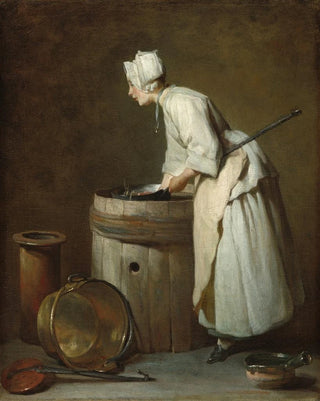Art print | The kitchen maid - Jean Siméon Chardin


View from behind

Frame (optional)
In the fascinating world of 18th-century French painting, "The Maidservant of the Pantry" by Jean Siméon Chardin stands out for its ability to capture the beauty of everyday life with unmatched delicacy. The artwork immerses us in the intimacy of a domestic scene, where the simplicity of gestures and objects transforms into a true ode to life. The soft light, warm colors, and meticulous details invite the viewer to contemplate not only the depicted scene but also the emotion it conveys. This art print of "The Maidservant of the Pantry" allows us to get closer to Chardin's artistic legacy, while immersing ourselves in a moment frozen in time, imbued with serenity and beauty.
Style and uniqueness of the work
Chardin's style is often characterized by his ability to combine realism and poetry. In "The Maidservant of the Pantry," the artist manages to transcend the banality of daily life, revealing an emotional depth that touches the heart. The composition focuses on the figure of the maidservant, whose concentrated attitude and contemplative gaze testify to a moment of pause amid the hustle of domestic work. The objects surrounding her, carefully arranged, become active participants in the scene, demonstrating artisanal craftsmanship and attention to detail that are signature to Chardin. The color palette, subtle and harmonious, plays a key role in the overall atmosphere of the work, creating a perfect balance between shadow and light. Every element seems to have been chosen with care, contributing to the visual harmony and the silent narration of the canvas.
The artist and his influence
Jean Siméon Chardin, born in 1699, is often regarded as one of the masters of still life and genre painting. His ability to depict daily life with such finesse and humanity marked his era and continues to inspire generations of artists. Chardin moved away from the conventions of academic painting of his time, preferring to explore the world of simple objects and domestic scenes. His influence extends...

Matte finish

View from behind

Frame (optional)
In the fascinating world of 18th-century French painting, "The Maidservant of the Pantry" by Jean Siméon Chardin stands out for its ability to capture the beauty of everyday life with unmatched delicacy. The artwork immerses us in the intimacy of a domestic scene, where the simplicity of gestures and objects transforms into a true ode to life. The soft light, warm colors, and meticulous details invite the viewer to contemplate not only the depicted scene but also the emotion it conveys. This art print of "The Maidservant of the Pantry" allows us to get closer to Chardin's artistic legacy, while immersing ourselves in a moment frozen in time, imbued with serenity and beauty.
Style and uniqueness of the work
Chardin's style is often characterized by his ability to combine realism and poetry. In "The Maidservant of the Pantry," the artist manages to transcend the banality of daily life, revealing an emotional depth that touches the heart. The composition focuses on the figure of the maidservant, whose concentrated attitude and contemplative gaze testify to a moment of pause amid the hustle of domestic work. The objects surrounding her, carefully arranged, become active participants in the scene, demonstrating artisanal craftsmanship and attention to detail that are signature to Chardin. The color palette, subtle and harmonious, plays a key role in the overall atmosphere of the work, creating a perfect balance between shadow and light. Every element seems to have been chosen with care, contributing to the visual harmony and the silent narration of the canvas.
The artist and his influence
Jean Siméon Chardin, born in 1699, is often regarded as one of the masters of still life and genre painting. His ability to depict daily life with such finesse and humanity marked his era and continues to inspire generations of artists. Chardin moved away from the conventions of academic painting of his time, preferring to explore the world of simple objects and domestic scenes. His influence extends...






